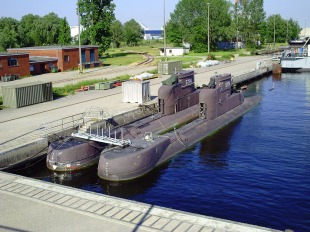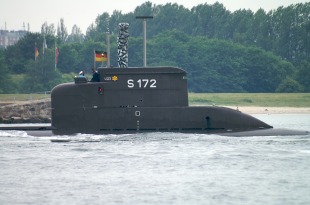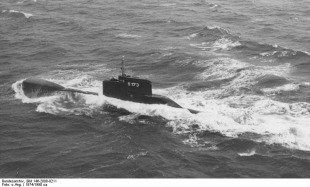Type 206 submarine
Basic information
Type:
Country of build:
Planned:
18
Completed:
18
Retired:
16
In service:
1973 – present (51 year)
Ship measurements
Displacement:
449 t
Submerged displacement:
490 t
Length:
48.49 m
Beam:
4.58 m
Machine
Propulsion:
- 2 * MTU 12V 493, 4-stroke diesel engines
- 2 * Asea Brown Boveri-generators
- 1 * Siemens-Schuckert-Werke electric motor
- 1 * shaft
- 1 * five (Type 206) or seven (Type 206A) blade propeller
Speed:
10 knots
Submerged speed:
17 knots
Test depth:
200 m
Range:
4,500 nautical miles (8,300 km; 5,200 mi) at 6 knots (11 km/h; 6.9 mph)
Personnel
Complement:
22
Combat assets
Electronics:
- STN Atlas DBQS-21 (CSU83) submarine sonar
- Thomson-CSF DUUX 2 passive rangefinder sonar
- Safare VELOX sonar interceptEDO-900 active mine avoidance sonar
- Thomson-CSF Calypso II surveillance and navigation radar
- Thomson-CSF DR-2000U ESM system with a Thorn-EMI SARIE
Armament:
- 8 * 533 mm torpedo tubes
- 8 * DM2A1 Seeaal (206) or DM2A3 Seehecht (206A) torpedoes
- 24 * mines can be carried externally
The Type 206 is a class of diesel-electric submarines (Uboats) developed by Howaldtswerke-Deutsche Werft (HDW). Its design is based on the preceding Type 205 submarine class. These small and agile submarines were built during the Cold War to operate in the shallow Baltic Sea and attack Warsaw Pact shipping in the event of military confrontation. The pressure hulls were built out of non-magnetic steel to counter the threat of magnetic naval mines and make detection with MAD sensors more difficult. The low emission profile allowed the submarines in exercises to intrude even into well-protected opposing forces such as carrier formations with their screen.
- Comments
No comments yet
Log in or Register to write comments
 en
en ru
ru uk
uk




 Colombian National Navy (Armada de Colombia)
Colombian National Navy (Armada de Colombia) German Navy (Deutsche Marine)
German Navy (Deutsche Marine) Nordseewerke Emden GmbH (NSWE)
Nordseewerke Emden GmbH (NSWE)